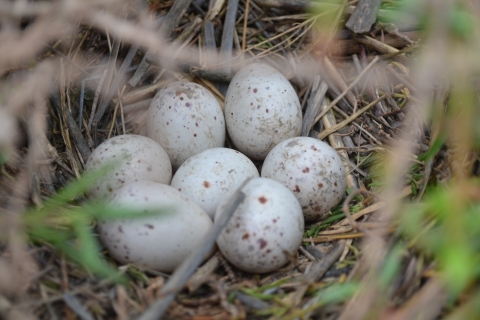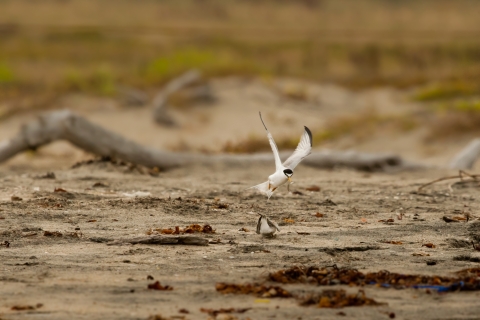Seasons of Wildlife
A small number of western snowy plover also nest in the river mouth areas and dunes from mid-March to mid-September. Peak nesting occurs from April through June.
Belding's Savannah sparrows use the higher salt marsh salt marsh
Salt marshes are found in tidal areas near the coast, where freshwater mixes with saltwater.
Learn more about salt marsh habitats, particularly pickleweed communities, for nesting. Nesting occurs anywhere from March to August.
The Tijuana River Estuary is located along the Pacific Flyway and is used for migration and wintering habitat for a variety of waterfowl and shorebirds. Wintering waterfowl include pintail, cinnamon teal, American widgeon, surf scoter, and ruddy duck. Reserve wetlands are important habitats for a large number of shorebirds (shorebirds account for the majority of the migratory bird population).
While about 20 species occur regularly along the sandflats and mudflats of the estuary, four species: willet, dowitcher, western sandpiper, and marbled godwit account for most of the shorebird population throughout the year. Abundance and species composition fluctuate seasonally. Intertidal sand and mudflats support the largest numbers of individuals and species.
Featured Species
Bird populations have been an important factor in the special protective status attributed to the Tijuana Estuary. Over 370 bird species are reported for the area.
Birds use the wide array of habitats present in the lower and upper estuary, including the ocean beach and dunes, mudflats, mudbanks, salt marshes, and riparian riparian
Definition of riparian habitat or riparian areas.
Learn more about riparian areas. A complete list of birds observed at the Reserve can be obtained at the Visitor Center. Five federally listed threatened or endangered birds occur regularly in the Reserve: the light-footed Ridgway’s rail (Rallus longirostris levipes), the California least tern (Sternulae antillarum), least Bell's vireo (Vireo belli pusillus), the California gnatcatcher (gnolioptia californica), and the western snowy plover (Charadrius alexandrinus nivosus). Belding's savannah sparrow (Passerculus sandwichensis beldingi) is listed as endangered by the State of California. Other regionally or locally rare species include the elegant tern, black skimmer, and northern harrier. The light-footed Ridgway’s rail, California least tern, western snowy plover, least Bell's vireo, and Belding's savannah sparrow nest within the estuary.
The decline of the light-footed clapper rail population in southern California is associated with the encroachment and destruction of coastal salt marshes. In 2012, 520 pairs were recorded for the entire population, from Point Mugu in Ventura County, to Tijuana Slough NWR.
A total of 305 California least tern pairs were reported in the Reserve for 2006, with 57-80 chicks fledged. Fences and temporary enclosures have been built to protect the nesting areas. However, nests and fledglings are vulnerable to vehicle, horse, and foot traffic on the beach. Tern reproduction can be severely impacted by predation from an array of predator species. A small number of western snowy plover also nest in the river mouth areas and dunes from mid-March to mid-September. Peak nesting occurs from April through June. Both California least terns and western snowy plovers are extremely vulnerable to other avian predators such as owls, hawks, and the rare gull-billed tern.
Belding's Savannah sparrows use the higher salt marsh salt marsh
Salt marshes are found in tidal areas near the coast, where freshwater mixes with saltwater.
Learn more about salt marsh habitats, particularly pickleweed communities, for nesting. Nesting occurs anywhere from March to August. The long breeding season of this species, coupled with its sensitivity to disturbance, requires that human activities in the upper marsh be restricted for most of the year to avoid further declines in the population (Zedler, 1982b).
Least Bell's vireo nests in the riparian vegetation adjacent to intermittent streams and channels of the Tijuana River. Willow thickets are the main territorial sites both in the southern and eastern portions of the Reserve.
The Tijuana River Estuary is located along the Pacific Flyway and is used for migration and wintering habitat for a variety of waterfowl and shorebirds. Wintering waterfowl include pintail, cinnamon teal, American widgeon, surf scoter, and ruddy duck. Reserve wetlands are important habitats for a large number of shorebirds (shorebirds account for the majority of the migratory bird population). While about 20 species occur regularly along the sandflats and mudflats of the estuary, four species -- willet, dowitcher, western sandpiper, and marbled godwit -- account for most of the shorebird population throughout the year (Boland, 1981). Abundance and species composition fluctuate seasonally. Intertidal sand and mudflats support the largest numbers of individuals and species.




